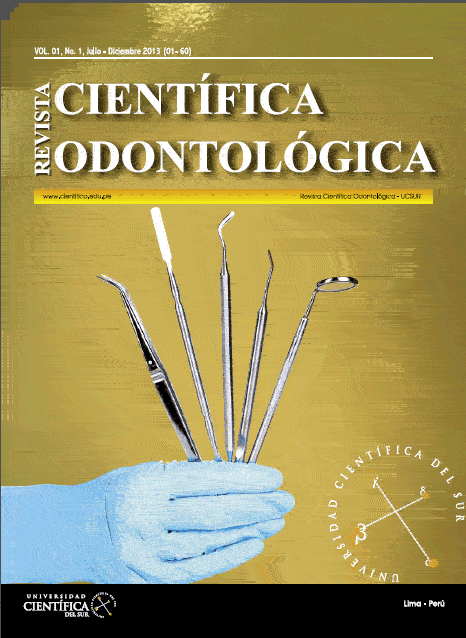Principales Factores de Virulencia de Periodontopatógenos Orales - Dentaid
DOI:
https://doi.org/10.21142/2523-2754-0101-2013-%25pKeywords:
Periodoncia, Gingivitis, Bacterias, Aggregatibacter ActinomycetemcomitansAbstract
La gingivitis y la periodontitis son enfermedades causadas en un inicio por un conjunto específico de bacterias orales. Aun así, ninguna de estas bacterias es capaz por sí sola de generar una enfermedad tan compleja como la periodontitis, sino que el proceso está orquestado por un selecto grupo de microorganismos con múltiples interacciones que promueven la respuesta inflamatoria, la destrucción tisular y la reabsorción ósea. Entre los periodontopatógenos más destacados se encuentran Aggregatibacter actinomycetemcomitans y Porphyromonas gingivalis.Downloads
References
Socransky SS, Haffajee AD. Periodontal microbial ecology. Periodontol 2000. 2005;38:135-87.
Slots J. Actinobacillus actinomycetemcomitans and Porphyromonas gingivalis in periodontal disease: introduction. Periodontol 2000. 1999;20:7-13.
Van Winkelhoff AJ, Slots J. Actinobacillus actinomycetemcomitans and Porphyromonas gingivalis in nonoral infections. Periodontol 2000. 1999;20:122-35.
Bostanci N, Belibasakis GN. Porphyromonas gingivalis: an invasive and evasive opportunistic oral pathogen. FEMS Microbiol Lett.2012;333:1-9.
Henderson B, Nair SP, Ward JM, Wilson M. Molecular pathogenicity of the oral opportunistic pathogen Actinobacillus actinomycetemcomitans. Annu Rev Microbiol. 2003;57:29-55.
Nobbs AH, Jenkinson HF, Jakubovics NS. Stick to your gums: mechanisms of oral microbial adherence. J Dent Res. 2011;90:1271-8.
Esberg A, Löfgren-Burström A, Ohman U, Strömberg N. Host and bacterial phenotype variation in adhesion of Streptococcus mutans to matched human hosts. Infect Immun. 2012;80:3869-79.
Paster BJ, Boches SK, Galvin JL, Ericson RE, Lau CN, Levanos VA, Sahasrabudhe A, Revista Científica Odontológica. 2013;1:56-59 Universidad Científica del Sur 59 Dewhirst FE. Bacterial diversity in human subgingival plaque. J Bacteriol. 2001;183: 3770-83.
Jauregui CE, Wang Q, Wright CJ, Takeuchi H, Uriarte SM, Lamont RJ. Suppression of T-cell chemokines by Porphyromonas gingivalis. Infect Immun. 2013;81:2288-95.
Shenker BJ, Vitale LA, Welham DA. Immune suppression induced by Actinobacillus actinomycetemcomitans: effects on immunoglobulin production by human B cells. Infect Immun. 1990;58:3856-62.
Lamont RJ, Jenkinson HF. Life below the gum line: pathogenic mechanisms of Porphyromonas gingivalis. Microbiol Mol Biol Rev.1998;62:1244-63.
Yoshimura F, Murakami Y, Nishikawa K, Hasegawa Y, Kawaminami S. Surface components of Porphyromonas gingivalis. J Periodontal Res. 2009;44:1-12.
Nagano K, Hasegawa Y, Abiko Y, Yoshida Y, Murakami Y, Yoshimura F. Porphyromonas gingivalis FimA fimbriae: fimbrial assembly by fimA alone in the fim gene cluster and differential antigenicity among fimA genotypes. PLoS One. 2012;7: e43722.
O-Brien-Simpson NM, Veith PD, DashperSG, Reynolds EC. Porphyromonas gingivalis
gingipains: the molecular teeth of a microbial vampire. Curr Protein Pept Sci. 2003;4:409-26.
Guo Y, Nguyen KA, Potempa J. Dichotomy of gingipains action as virulence factors: from cleaving substrates with the precision of a surgeon’s knife to a meat chopper-like brutal degradation of proteins. Periodontol 2000.2010;54:15-44.
Fitzpatrick RE, Wijeyewickrema LC, Pike RN. The gingipains: scissors and glue of the periodontal pathogen, Porphyromonas gingivalis. Future Microbiol. 2009;4:471-87.
Singh A, Wyant T, Anaya-Bergman C, Aduse- Opoku J, Brunner J, Laine ML, Curtis MA, Lewis JP. The capsule of Porphyromonas
gingivalis leads to a reduction in the host inflammatory response, evasion of phagocytosis, and increase in virulence. Infect Immun. 2011;79:4533-42.
Brunner J, Scheres N, El Idrissi NB, Deng DM, Laine ML, van Winkelhoff AJ, Crielaard W. The capsule of Porphyromonas gingivalis reduces the immune response of human gingival fibroblasts. BMC Microbiol. 2010;11;10-5.
Johansson A. Aggregatibacter actinomycetemcomitans leukotoxin: a powerful tool with capacity to cause imbalance in the host inflammatory response. Toxins. 2005;3:242-59.
Smith JL, Bayles DO. The contribution of cytolethal distending toxin to bacterial pathogenesis. Crit Rev Microbiol. 2006;32: 224-7.
Downloads
Published
Issue
Section
License

Este obra está bajo una licencia de Creative Commons Reconocimiento 4.0 Internacional.












